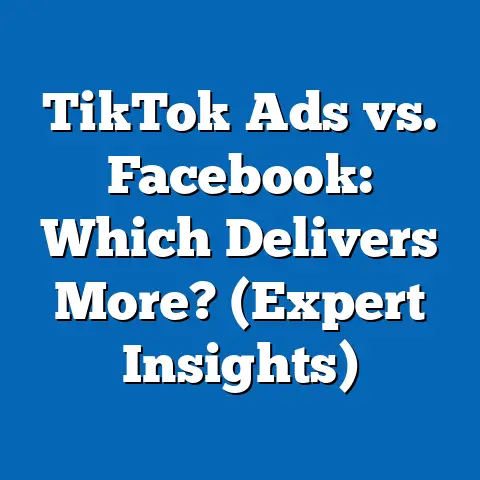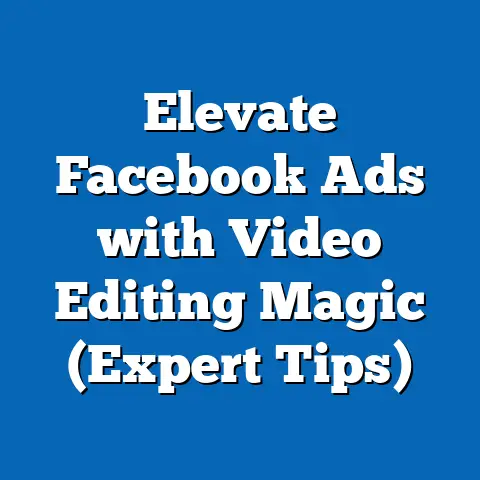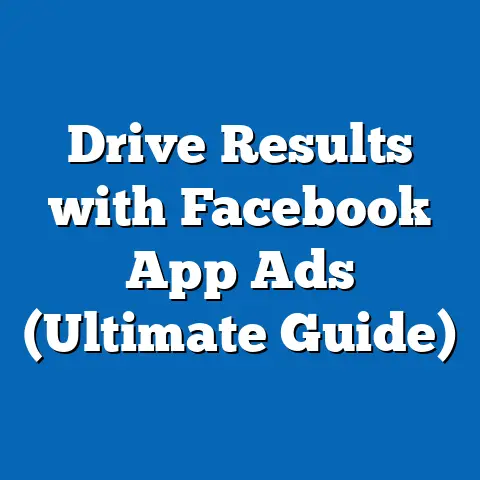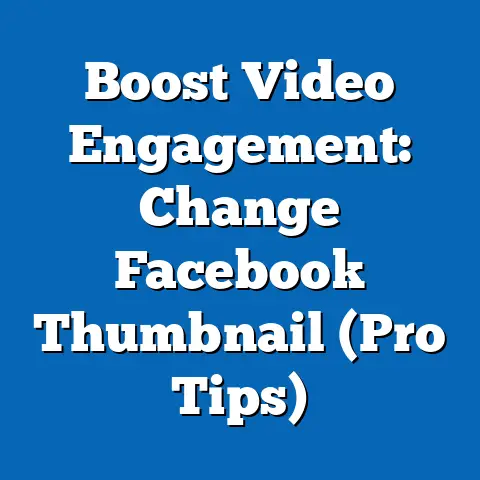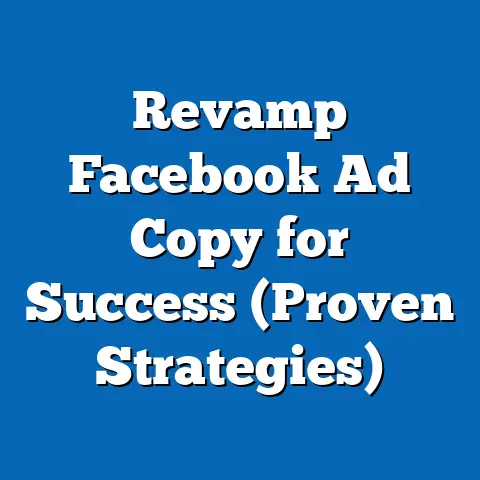Fixing Facebook Ad Failures (Essential Recovery Strategies)
Facebook advertising. Just the words alone can conjure up a mix of excitement and dread for any business owner or marketer. On one hand, it’s the promise of reaching billions of potential customers with laser-like precision. On the other, it’s the potential for wasted ad spend and lackluster results that can leave you feeling deflated and questioning your entire strategy. I’ve been there. I remember launching a campaign for a local bakery, convinced I had the perfect targeting and creative, only to see it fall completely flat. It was a humbling experience, but it taught me invaluable lessons about the importance of understanding the platform, analyzing data, and adapting quickly.
We’re going to dive deep into the common pitfalls of Facebook ads, explore how to analyze your performance metrics, and, most importantly, equip you with actionable recovery strategies that you can implement immediately. I’ll share my own experiences, along with insights from industry experts, to help you navigate the complexities of Facebook advertising and ultimately achieve your business goals.
So, if you’re tired of throwing money at Facebook ads with little to show for it, or if you’re simply looking to improve your existing campaigns, then you’re in the right place. Let’s get started!
Section 1: Understanding the Common Pitfalls of Facebook Ads
Before we can talk about fixing failures, we need to understand what causes them in the first place. Think of it like a doctor diagnosing an illness – you need to identify the root cause before you can prescribe the right treatment.
1.1 The Landscape of Facebook Advertising
Facebook is a behemoth. With billions of active users, it’s a platform that offers unparalleled reach for businesses of all sizes. But that reach comes with complexity. Facebook’s advertising platform is a sophisticated ecosystem with its own language, rules, and best practices.
The beauty of Facebook advertising lies in its targeting capabilities. You can target users based on demographics, interests, behaviors, and even their connections. This level of granularity allows you to reach specific audiences who are most likely to be interested in your products or services.
However, the landscape is constantly shifting. Facebook’s algorithm is always evolving, and new features and ad formats are regularly introduced. This means that what worked six months ago might not be as effective today. Staying up-to-date with the latest trends and best practices is crucial for success.
1.2 Identifying Key Reasons for Ad Failures
Now, let’s get down to the nitty-gritty. Why do Facebook ads fail? Here are some of the most common reasons I’ve seen, both in my own experience and working with other businesses:
- Misaligned Targeting: This is often the biggest culprit. If you’re targeting the wrong audience, your ads simply won’t resonate. Maybe you’re targeting too broad of an audience, or perhaps your targeting is based on outdated assumptions about your customer base.
- Poor Ad Creative: Even with perfect targeting, your ads will fall flat if the creative is uninspired. This includes both the visuals and the copy. Your ads need to be visually appealing, attention-grabbing, and clearly communicate the value proposition of your product or service.
- Ineffective Budgeting: It’s easy to overspend on Facebook ads without seeing a return. Many advertisers set their budgets too high without properly testing and optimizing their campaigns. On the other hand, setting your budget too low can also be detrimental, as it might not give your ads enough exposure to generate meaningful results.
- Inadequate Tracking: If you’re not tracking your results properly, you’re flying blind. You need to be able to track key metrics like clicks, conversions, and return on ad spend (ROAS) to understand what’s working and what’s not. Without proper tracking, you won’t be able to optimize your campaigns effectively.
- Lack of A/B Testing: A/B testing is the process of comparing two versions of an ad to see which performs better. If you’re not A/B testing your ads, you’re missing out on valuable insights that can help you improve your results.
- Ignoring the Customer Journey: Facebook ads are just one piece of the puzzle. You need to consider the entire customer journey, from the moment someone sees your ad to the point of purchase. If your landing page is poorly designed or your checkout process is cumbersome, you’ll lose potential customers even if your ads are performing well.
- Not Adapting to Algorithm Changes: As I mentioned earlier, Facebook’s algorithm is constantly evolving. If you’re not staying up-to-date with these changes and adapting your strategies accordingly, you’ll likely see your results decline over time.
Real-World Example: I once worked with a clothing boutique that was struggling with their Facebook ads. They were targeting a broad audience of women aged 18-45 with generic ads featuring their latest collection. After analyzing their data, we realized that their most successful products were actually targeted towards a specific niche: young professionals looking for stylish workwear. We refined their targeting to focus on this niche and revamped their ad creative to highlight the specific benefits of their workwear collection. The result? Their ad performance skyrocketed, and they saw a significant increase in sales.
1.3 The Emotional Impact of Ad Failures
It’s easy to get caught up in the technical aspects of Facebook advertising and forget about the human element. But the truth is, ad failures can have a significant emotional impact on marketers and business owners.
I’ve seen firsthand the frustration, disappointment, and even self-doubt that can arise when a campaign doesn’t perform as expected. It can be especially disheartening when you’ve poured your heart and soul into creating what you believe is a winning strategy, only to see it fall flat.
It’s important to remember that failure is a part of the learning process. Even the most successful marketers have experienced their fair share of setbacks. The key is to learn from your mistakes, adapt your strategies, and keep moving forward.
Key Takeaway: Understanding the common pitfalls of Facebook ads is the first step towards fixing them. By identifying the root causes of your failures, you can develop targeted recovery strategies that will improve your results. Don’t let the emotional impact of ad failures discourage you. Embrace them as learning opportunities and keep experimenting until you find what works.
Section 2: Analyzing Ad Performance Metrics
Okay, so you’ve identified some potential reasons why your Facebook ads might be failing. Now it’s time to put on your detective hat and dive into the data. Analyzing your ad performance metrics is like reading the clues in a mystery novel – it will help you uncover the truth about what’s working and what’s not.
2.1 The Importance of Data Analysis
I can’t stress this enough: data analysis is the backbone of successful Facebook advertising. Without it, you’re essentially throwing darts in the dark. Data provides you with objective insights into how your ads are performing, allowing you to make informed decisions about how to optimize your campaigns.
By analyzing your metrics, you can identify areas where your ads are falling short. Are people not clicking on your ads? Is your conversion rate low? Are you spending too much money to acquire a customer? These are all questions that data can help you answer.
2.2 Key Metrics to Monitor
There are a lot of metrics available in Facebook Ads Manager, but some are more important than others. Here are some of the key metrics I recommend monitoring:
- Click-Through Rate (CTR): This is the percentage of people who see your ad and click on it. A high CTR indicates that your ad is relevant and engaging to your target audience. A low CTR suggests that your ad creative or targeting might need some work.
- Interpretation: A good CTR varies depending on the industry, but generally, a CTR of 1% or higher is considered good.
- Relationship to Other Metrics: CTR is closely related to relevance score. A higher relevance score often leads to a higher CTR.
- Cost Per Mille (CPM): This is the cost you pay for 1,000 impressions of your ad. CPM is a good indicator of how competitive your target audience is. A high CPM suggests that you’re targeting a popular audience, while a low CPM suggests that you’re targeting a less competitive audience.
- Interpretation: CPM varies widely depending on the industry and targeting. Benchmarks can be found online, but it’s important to compare your CPM to your own historical data.
- Relationship to Other Metrics: CPM is related to reach. A lower CPM allows you to reach more people for the same budget.
- Conversion Rate: This is the percentage of people who click on your ad and then complete a desired action, such as making a purchase, filling out a form, or subscribing to your email list. A high conversion rate indicates that your landing page is effective and your offer is compelling. A low conversion rate suggests that your landing page or offer might need some work.
- Interpretation: Conversion rate varies greatly depending on the industry and the type of conversion.
- Relationship to Other Metrics: Conversion rate is directly related to ROAS. A higher conversion rate leads to a higher ROAS.
- Return on Ad Spend (ROAS): This is the amount of revenue you generate for every dollar you spend on advertising. ROAS is the ultimate measure of your campaign’s success. A high ROAS indicates that your ads are generating a significant return on investment.
- Interpretation: A good ROAS depends on your business goals and profit margins. Generally, a ROAS of 3:1 or higher is considered good.
- Relationship to Other Metrics: ROAS is influenced by all of the other metrics mentioned above.
- Cost Per Acquisition (CPA): This is the cost you pay to acquire a new customer. CPA is a key metric for understanding the profitability of your campaigns.
- Interpretation: A good CPA depends on your industry and customer lifetime value.
- Relationship to Other Metrics: CPA is related to conversion rate and CPM.
- Relevance Score: Facebook assigns a relevance score to each of your ads based on how relevant it is to your target audience. A high relevance score indicates that your ad is resonating with your audience, which can lead to lower costs and better results.
- Interpretation: Relevance score is on a scale of 1 to 10, with 10 being the highest.
- Relationship to Other Metrics: Relevance score is closely related to CTR and CPM.
- Interpretation: A good CTR varies depending on the industry, but generally, a CTR of 1% or higher is considered good.
- Relationship to Other Metrics: CTR is closely related to relevance score. A higher relevance score often leads to a higher CTR.
- Interpretation: CPM varies widely depending on the industry and targeting. Benchmarks can be found online, but it’s important to compare your CPM to your own historical data.
- Relationship to Other Metrics: CPM is related to reach. A lower CPM allows you to reach more people for the same budget.
- Interpretation: Conversion rate varies greatly depending on the industry and the type of conversion.
- Relationship to Other Metrics: Conversion rate is directly related to ROAS. A higher conversion rate leads to a higher ROAS.
- Interpretation: A good ROAS depends on your business goals and profit margins. Generally, a ROAS of 3:1 or higher is considered good.
- Relationship to Other Metrics: ROAS is influenced by all of the other metrics mentioned above.
- Interpretation: A good CPA depends on your industry and customer lifetime value.
- Relationship to Other Metrics: CPA is related to conversion rate and CPM.
- Interpretation: Relevance score is on a scale of 1 to 10, with 10 being the highest.
- Relationship to Other Metrics: Relevance score is closely related to CTR and CPM.
2.3 Using Facebook Analytics and Insights
Facebook provides a wealth of analytics and insights that you can use to understand your ad performance and audience behavior.
Here are some of the tools I recommend using:
- Facebook Ads Manager: This is your central hub for managing and analyzing your Facebook ads. It provides a comprehensive overview of your campaign performance, as well as detailed reports on individual ads and ad sets.
- Facebook Analytics: This tool allows you to track user behavior on your website or app. You can use it to understand how people are interacting with your content, which pages they’re visiting, and what actions they’re taking.
- Facebook Audience Insights: This tool provides valuable insights into your target audience, including their demographics, interests, behaviors, and purchase patterns. You can use this information to refine your targeting and create more relevant ads.
Practical Example: Let’s say you’re running a Facebook ad campaign for a new e-commerce store selling handmade jewelry. You notice that your CTR is low, but your conversion rate is high. This suggests that your ad creative isn’t compelling enough to attract clicks, but once people land on your website, they’re impressed with your products and complete a purchase. In this case, you would want to focus on improving your ad creative to increase your CTR.
Key Takeaway: Data analysis is essential for understanding your Facebook ad performance and identifying areas for improvement. By monitoring key metrics and using Facebook’s analytics tools, you can gain valuable insights into your audience behavior and optimize your campaigns for better results.
Now it’s time to roll up our sleeves and get to work on fixing those ad failures. Here are some essential recovery strategies that I’ve found to be highly effective:3.1 Reevaluating Target Audience
As I mentioned earlier, misaligned targeting is often the biggest reason why Facebook ads fail. It’s crucial to ensure that you’re targeting the right audience with the right message.
Here are some methods for refining your audience targeting:
- Creating Custom Audiences: Custom audiences allow you to target people who have already interacted with your business, such as website visitors, email subscribers, or customers. This is a powerful way to re-engage people who are already familiar with your brand.
- Building Lookalike Audiences: Lookalike audiences allow you to target people who are similar to your existing customers or website visitors. Facebook uses its data to identify people who share similar demographics, interests, and behaviors with your source audience.
- Using Audience Insights: Facebook Audience Insights provides valuable information about your target audience, including their demographics, interests, behaviors, and purchase patterns. You can use this information to refine your targeting and create more relevant ads.
Personal Story: I once worked with a fitness studio that was struggling to attract new members through Facebook ads. They were targeting a broad audience of people interested in fitness and wellness. After using Facebook Audience Insights, we discovered that their ideal customer was actually a busy professional aged 30-45 who was looking for a convenient and effective workout solution. We refined their targeting to focus on this specific demographic and revamped their ad creative to highlight the convenience and effectiveness of their workouts. The result? Their ad performance improved dramatically, and they saw a significant increase in new memberships.
3.2 Revamping Ad Creative
Even with perfect targeting, your ads will fall flat if the creative is uninspired. Your ads need to be visually appealing, attention-grabbing, and clearly communicate the value proposition of your product or service.
Here are some tips for improving your ad creative:
- Use High-Quality Visuals: Your visuals are the first thing people will see, so make sure they’re high-quality and visually appealing. Use professional photos or videos that showcase your products or services in the best possible light.
- Write Compelling Copy: Your ad copy should be clear, concise, and persuasive. Highlight the benefits of your product or service and tell people what you want them to do (e.g., “Shop Now,” “Learn More,” “Sign Up”).
- A/B Test Different Creatives: A/B testing is the process of comparing two versions of an ad to see which performs better. Test different visuals, headlines, and body copy to see what resonates with your audience.
Example: Instead of saying “Our product is great,” try something like “Solve your [problem] with our [product] and experience [benefit].”
Pro Tip: Use power words in your ad copy to make it more persuasive. Power words are words that evoke emotion and create a sense of urgency or excitement. Some examples of power words include “free,” “new,” “exclusive,” “limited,” and “guaranteed.”
3.3 Adjusting Budget and Bidding Strategies
Optimizing your budget and bidding strategies is crucial for maximizing your return on ad spend.
Here are some tips for adjusting your budget and bidding strategies:
- Start Small and Scale Up: Don’t start with a huge budget right away. Start with a small budget and test different targeting and creative options. Once you’ve found what works, you can gradually scale up your budget.
- Explore Different Bidding Strategies: Facebook offers a variety of bidding strategies, including automatic bidding, manual bidding, and cost-per-click (CPC) bidding. Experiment with different bidding strategies to see which one works best for your campaign goals.
- Monitor Your Results Regularly: Keep a close eye on your ad performance and adjust your budget and bidding strategies as needed. If you’re seeing good results, you can increase your budget. If you’re not seeing good results, you can decrease your budget or try a different bidding strategy.
Understanding Bidding: Facebook uses an auction system to determine which ads are shown to users. Your bid represents the amount you’re willing to pay for each impression or click.
- Automatic Bidding: Facebook automatically sets your bids based on your campaign goals and budget.
- Manual Bidding: You set your bids manually, giving you more control over your ad spend.
3.4 Implementing Retargeting Campaigns
Retargeting is a powerful strategy to re-engage users who have previously interacted with your brand. It involves showing ads to people who have visited your website, viewed your products, or engaged with your content.
Here are some tips for setting up retargeting campaigns effectively:
- Install the Facebook Pixel: The Facebook Pixel is a piece of code that you install on your website to track user behavior. It allows you to track which pages people are visiting, what actions they’re taking, and whether they’re completing a purchase.
- Create Custom Audiences Based on Website Activity: Use the Facebook Pixel to create custom audiences based on specific website activity, such as people who have visited your product pages, added items to their cart, or abandoned their checkout.
- Show Relevant Ads: Show ads that are relevant to the specific actions people have taken on your website. For example, if someone added an item to their cart but didn’t complete the purchase, show them an ad featuring that specific item with a special discount.
Example: An e-commerce store can retarget users who viewed a specific product but didn’t add it to their cart with an ad showcasing that product and offering free shipping.
3.5 Utilizing Social Proof and User-Generated Content
Social proof is the idea that people are more likely to trust and buy from a brand if they see that other people are already doing so. User-generated content (UGC) is content created by your customers, such as reviews, testimonials, photos, and videos.
Here are some ways to leverage social proof and UGC in your Facebook ads:
- Include Testimonials: Feature testimonials from satisfied customers in your ads. This will help build trust and credibility with potential customers.
- Showcase User-Generated Content: Share photos and videos of your customers using your products or services. This will help people visualize themselves using your products or services and make them more likely to buy.
- Run Contests and Giveaways: Encourage your customers to create content about your brand by running contests and giveaways. This will help you generate a lot of high-quality UGC that you can use in your ads.
Key Takeaway: Implementing these recovery strategies can help you turn your Facebook ad failures into successes. Reevaluate your targeting, revamp your creative, adjust your budget and bidding strategies, implement retargeting campaigns, and leverage social proof and user-generated content.
Section 4: Continuous Learning and Adaptation
Facebook advertising is not a set-it-and-forget-it kind of thing. It’s a dynamic and ever-evolving landscape that requires continuous learning and adaptation.
4.1 The Importance of Staying Updated
Facebook is constantly rolling out new features, algorithm updates, and best practices. It’s crucial to stay up-to-date with these changes and adapt your strategies accordingly.
Here are some resources for ongoing education:
- Facebook Business Help Center: This is your go-to resource for all things Facebook advertising. It provides detailed information on all of Facebook’s advertising features and best practices.
- Facebook Marketing Partners: Facebook Marketing Partners are companies that have been vetted by Facebook and are experts in Facebook advertising. They can provide you with valuable insights and support.
- Industry Blogs and Publications: There are many industry blogs and publications that cover Facebook advertising. These resources can help you stay up-to-date with the latest trends and best practices.
- Online Courses and Webinars: There are many online courses and webinars that teach you how to use Facebook advertising effectively. These resources can provide you with in-depth knowledge and practical skills.
4.2 Embracing a Test-and-Learn Culture
The best way to learn what works and what doesn’t is to experiment. Embrace a test-and-learn culture where experimentation is welcomed, and each failure is viewed as an opportunity for growth.
Here are some tips for embracing a test-and-learn culture:
- Set Clear Goals: Before you start experimenting, set clear goals for what you want to achieve. This will help you measure the success of your experiments.
- Test One Variable at a Time: When you’re testing different ad creatives or targeting options, test only one variable at a time. This will help you isolate the impact of each variable.
- Track Your Results: Keep a close eye on your results and track what’s working and what’s not. This will help you make informed decisions about how to optimize your campaigns.
- Document Your Learnings: Document your learnings from each experiment. This will help you avoid making the same mistakes in the future.
4.3 Building a Feedback Loop
Create a feedback loop where insights from past campaigns inform future strategies. This involves collecting data, analyzing results, and using those insights to improve your future campaigns.
Here are some tips for building a feedback loop:
- Collaborate with Your Team: Encourage collaboration between your marketing team and data analysts. This will help ensure that everyone is on the same page and that insights are being shared effectively.
- Use Data Visualization Tools: Use data visualization tools to create reports and dashboards that make it easy to understand your ad performance.
- Schedule Regular Reviews: Schedule regular reviews of your ad performance to identify trends and patterns.
Key Takeaway: Continuous learning and adaptation are essential for long-term success with Facebook advertising. Stay updated with the latest trends and best practices, embrace a test-and-learn culture, and build a feedback loop to ensure that your strategies are constantly improving.
Conclusion: Turning Failures into Opportunities
Facebook advertising can be a powerful tool for growth and engagement, but it’s not without its challenges. Failures are inevitable, but they don’t have to be the end of the road. By understanding the common pitfalls of Facebook ads, analyzing your performance metrics, implementing effective recovery strategies, and embracing continuous learning and adaptation, you can turn your failures into opportunities for success.
Remember, every setback is a learning opportunity. Don’t be afraid to experiment, test new strategies, and push the boundaries of what’s possible. With the right mindset and the right tools, you can transform your Facebook ads into a powerful engine for growth and engagement.
So, go out there and conquer the world of Facebook advertising! I’m confident that with the knowledge and strategies you’ve gained from this article, you’ll be well on your way to achieving your business goals. Good luck!

